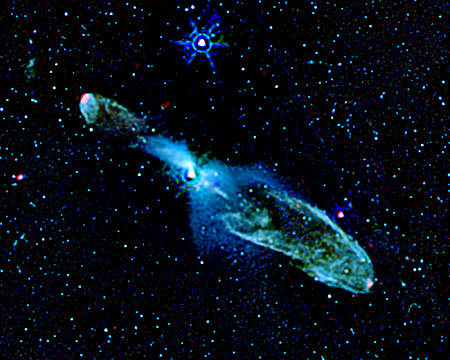It’s Wednesday, so that means its time for another “Where In The Universe” challenge to test your visual knowledge of the cosmos. See if you can name where in the Universe this image is from, and give yourself extra points if you can name the spacecraft responsible for the image. Make your guess and post a comment, but please no links to the answer. Check back sometime on Thursday to find the answer and see how you did.
UPDATE: The answer has now been posted below.
This one, I admit, was a little tough. But fun! Although I think a lot of people were too perplexed to post an answer.
This image was taken by the Spitzer Space Telescope, and it is of a star located 1,140 light-years away from Earth. The star is a small baby star named HH 46/47, and it appears to be blowing bubbles. The infant star can be seen as a white spot toward the center of the Spitzer image. The two bubbles are shown as hollow elliptical shells of bluish-green material extending from the star. Wisps of green in the image reveal warm molecular hydrogen gas, while the bluish tints are formed by starlight scattered by surrounding dust.
These bubbles formed when powerful jets of gas, traveling at 200 to 300 kilometers per second, or about 120 to 190 miles per second, smashed into the cosmic cloud of gas and dust that surrounds HH 46/47. The red specks at the end of each bubble show the presence of hot sulfur and iron gas where the star’s narrow jets are currently crashing head-on into the cosmic cloud’s gas and dust material.
Find out more about this Spitzer image here.
Check back next week for another Where In The Universe challenge!


Hm… polar jets, point source… A pulsar?
This time I’m quite stumped.
Great choice Nancy – like Jorge I am stumped! What a weird object.
Sure it looks like a supernova remnant but the space craft??? i really have no idea!!!
It is an interesting object Nancy!! Thanks…
Es un objeto Herbig-Haro, no se si 46/47, Spitzer?
It’s on your hard drive and on universe today’s server 🙂
I am stumped. I think the object is a galaxy with an active nucleus which is producing jets. I don’t think it is an SN remnant, for the dipole remnants are usually more symmetrical than this.
If I didn’t know what it was, I would guess a Klingon Bird of Prey (somebody else please tell me you can see it, too!)
Seems like a radio image to me. An active galaxy with two jets visible and forming radio lobes at the end of it… and a point source just above the galaxy.
Should be a ground based interferometer… VLA maybe?
Great choice, this one is HARD!
It’s a bipolar nebula, but without a scale or any indication of location, how to tell if it’s an AGN or a planetary nebula or a YSO?
It could be a composite image, with the faint point sources indicating an IR image (so either Spitzer or the Japanese IR observatory, also possible is the hi-res IR facility on the Hawaian mountaintop), and the fuzzy blue nebulosity and hexagonal artifacts around the bright point source being from Swift.
So, I have to pass on this one …
Looks to be a bipolar outflow from a young star, protostar, or Herbig-Haro (HH) object, though I have no idea what the particular object is (and, yeah, it looks like a Klingon Bird of Prey!). The bright ‘triangular’ star in the picture is a hallmark of the PSF of one of the Spitzer cameras.